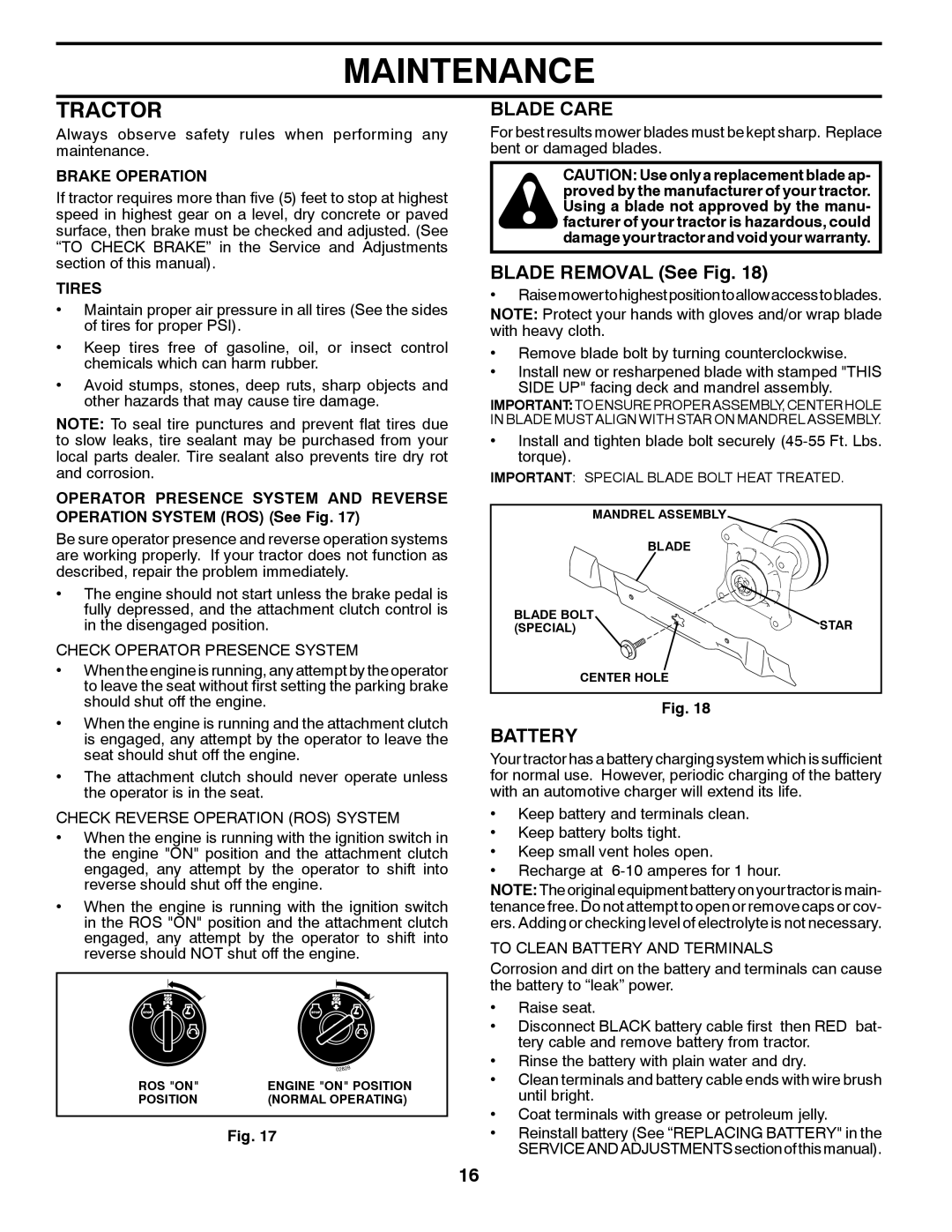
MAINTENANCE
TRACTOR
Always observe safety rules when performing any maintenance.
BRAKE OPERATION
If tractor requires more than five (5) feet to stop at highest speed in highest gear on a level, dry concrete or paved surface, then brake must be checked and adjusted. (See “TO CHECK BRAKE” in the Service and Adjustments section of this manual).
TIRES
•Maintain proper air pressure in all tires (See the sides of tires for proper PSI).
•Keep tires free of gasoline, oil, or insect control chemicals which can harm rubber.
•Avoid stumps, stones, deep ruts, sharp objects and other hazards that may cause tire damage.
NOTE: To seal tire punctures and prevent flat tires due to slow leaks, tire sealant may be purchased from your local parts dealer. Tire sealant also prevents tire dry rot and corrosion.
OPERATOR PRESENCE SYSTEM AND REVERSE OPERATION SYSTEM (ROS) (See Fig. 17)
Be sure operator presence and reverse operation systems are working properly. If your tractor does not function as described, repair the problem immediately.
•The engine should not start unless the brake pedal is fully depressed, and the attachment clutch control is in the disengaged position.
CHECK OPERATOR PRESENCE SYSTEM
•When the engine is running, any attempt by the operator to leave the seat without first setting the parking brake should shut off the engine.
•When the engine is running and the attachment clutch is engaged, any attempt by the operator to leave the seat should shut off the engine.
•The attachment clutch should never operate unless the operator is in the seat.
CHECK REVERSE OPERATION (ROS) SYSTEM
•When the engine is running with the ignition switch in the engine "ON" position and the attachment clutch engaged, any attempt by the operator to shift into reverse should shut off the engine.
•When the engine is running with the ignition switch in the ROS "ON" position and the attachment clutch engaged, any attempt by the operator to shift into reverse should NOT shut off the engine.
|
|
|
|
|
|
|
|
|
| 02828 | |
ROS "ON" | ENGINE "ON" POSITION | ||
POSITION | (NORMAL OPERATING) | ||
|
|
|
|
|
| Fig. 17 | |
BLADE CARE
For best results mower blades must be kept sharp. Replace bent or damaged blades.
CAUTION: Use only a replacement blade ap- proved by the manufacturer of your tractor. Using a blade not approved by the manu- facturer of your tractor is hazardous, could damage your tractor and void your warranty.
BLADE REMOVAL (See Fig. 18)
•Raisemowertohighestpositiontoallowaccesstoblades.
NOTE: Protect your hands with gloves and/or wrap blade with heavy cloth.
•Remove blade bolt by turning counterclockwise.
•Install new or resharpened blade with stamped "THIS SIDE UP" facing deck and mandrel assembly.
IMPORTANT:TOENSUREPROPERASSEMBLY,CENTERHOLE IN BLADE MUST ALIGN WITH STAR ON MANDREL ASSEMBLY.
•Install and tighten blade bolt securely
IMPORTANT: SPECIAL BLADE BOLT HEAT TREATED.
MANDREL ASSEMBLY |
|
BLADE |
|
BLADE BOLT | STAR |
(SPECIAL) |
CENTER HOLE
Fig. 18
BATTERY
Your tractor has a battery charging system which is sufficient for normal use. However, periodic charging of the battery with an automotive charger will extend its life.
•Keep battery and terminals clean.
•Keep battery bolts tight.
•Keep small vent holes open.
•Recharge at
NOTE:Theoriginalequipmentbatteryonyourtractorismain- tenance free. Do not attempt to open or remove caps or cov- ers. Adding or checking level of electrolyte is not necessary.
TO CLEAN BATTERY AND TERMINALS
Corrosion and dirt on the battery and terminals can cause the battery to “leak” power.
•Raise seat.
•Disconnect BLACK battery cable first then RED bat- tery cable and remove battery from tractor.
•Rinse the battery with plain water and dry.
•Clean terminals and battery cable ends with wire brush until bright.
•Coat terminals with grease or petroleum jelly.
•Reinstall battery (See “REPLACING BATTERY" in the SERVICEANDADJUSTMENTSsectionofthismanual).
16
